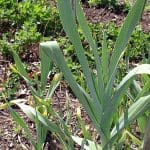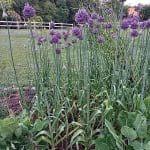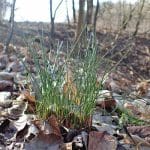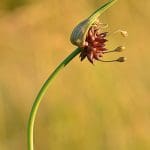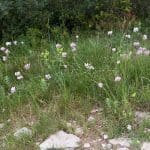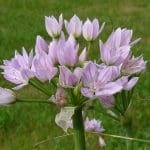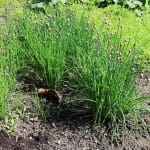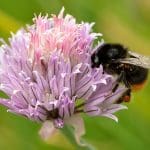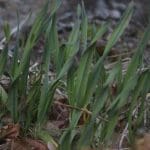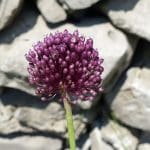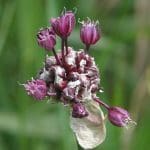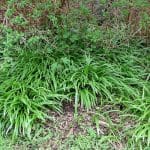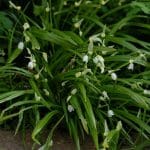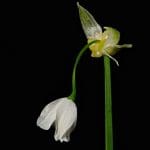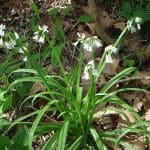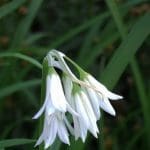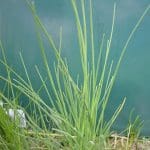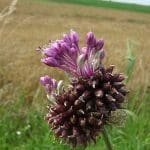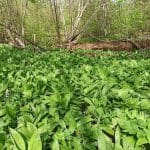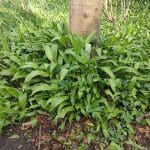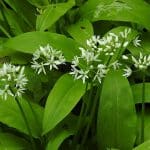Not just Wild Garlic! Popular as Wild garlic is, through this piece we’re going to look at the other great alliums that make up this delightful edible family.
Wild Garlic is also known as:
Ramsons
Stink Bombs
Stinking Nanny
Stinking Onions
Londoner’s Lillies
From some of these names you can guess that its smell isn’t always popular. The smell is caused by chemical compounds in the plant. These compounds don’t release a smell until the plant is mechanically damaged by, say trampling or cutting. When the plant is damaged the chemicals are broken down into volatile molecules that evaporate easily.
The main chemical responsible for the garlic smell in both cultivated garlic and wild garlic is Alliin. When it is broken down, as a result of physical damage to the plant, it produces Allicin, which we can smell. When we eat Allicin it is further broken down to produce Allyl-methyl-sulphide, which is responsible for “Garlic Breath”. So, yes, Wild Garlic will give you garlic breath too!
The purpose of Allicin and other sulphur containing compounds released when the plants are damaged is defence against pests. Allicin is able to penetrate the cells of bacteria and fungi, interfere with their cell processes and inhibit their growth.
Sustainability Note! Please remember that although many of these alliums have edible bulbs, it is illegal to dig up wild plants without landowners permission. (check out forager Fez’s article on the law here ) For the rarer plants you shouldn’t dig them up at all – we don’t want them getting any rarer! However Few flowered leek and Three-cornered leek are invasive species that are harming biodiversity by pushing other plants out – you can find out more from the Non-native Species Secretariat. So you are actually helping biodiversity if you eat as much as possible and dig as much as possible out – where you have permission, of course.
The Chemistry of Everyday Compounds:
Wild Garlic is a member of the Allium genus
| Kingdom: | Plantae |
| Order: | Asparagales |
| Family: | Amaryllidaceae |
| Genus: | Allium |
Allium is the Latin name for garlic. Other members of this genus include
Wild Leek, Allium ampeloprasum
Field Garlic, Allium oleraceum
Rosy Garlic, Allium roseum
Chives, Allium schoenoprasum
Sand Leek/Rocambole, Allium scorodoprasum
Few Flowered Garlic, Allium paradoxum
Three Cornered Leek, Allium triquetrum
Crow Garlic/Wild Onion, Allium vineale
To name a few. All of which can be used to add a garlic or onion flavour to various dishes.
Wild Leek, Allium ampeloprasum: Flowers July to August
The tallest of the alliums by far, this robust perennial reaches up to 2 metres high. It has four to ten grey-greenish, hollow, flat leaves, 50 cm long, 5 – 4cm wide, that are channelled and have a keel. They look like cultivated leeks before flowering. The flowers are cup shaped in dense spherical umbels 5 – 9 cm across.
Habitat: Rough vegetation, rocky ground, cliffs, hedgebanks, field borders, close to sea.
Distribution: Rare. Lancashire, SW England, Scilly Isles, Channel Islands, W Ireland. Very rare elsewhere – so best to admire rather than harvest.
Uses: Leaves are used for flavouring in Spain. The pre-flowering growth can be prepared as leeks, to which they are similar, although with a slightly garlic flavour. Bulbils can be used in place of garlic cloves.
Field Garlic, Allium oleraceum: Flowers June to August
Smooth stems up to 100cm, Two to four half round, solid Leaves (lower part hollow), which surround the lower part of the flower stem; up to 30m long. Flowers in 5 to 40 flowered umbel with pointed, papery bracts.
Habitat: Dry, rough, calcareous grassland, usually on steep, south-facing slopes.
Distribution: Scattered throughout England, rare elsewhere.
Uses: Use like chives; the bulbils as for Sand Leek or Crow Garlic.
Rosy Garlic, Allium roseum, Flowers May – June
Smooth stems up to 65cm. Wide, flat leaves up to 35cm long, 5 – 14mm wide. Flowers cup shaped in pink, many-flowered umbel, up to 7cm across.
Habitat: Rough ground, hedgebanks, roadsides. Introduced species that has been naturalised after escape from cultivation.
Distribution: South and South West England. Rare elsewhere.
Uses: The bulbils rather than the bulbs were used in the eighteenth century for sauces, salads and generally in place of cultivated garlic or shallots. The bulbils can be chopped finely or crushed and added to salads, dressing and cooked dishes. Leaves can be used in place of three-cornered garlic or chives.
Chives, Allium schoenoprasum, Flowers June-July
Smooth, hollow stems up to 50cm. Cylindrical, hollow leaves, up to 35cm. Flowers in dense, purple, spherical umbel, 1.5 – 5cm across on leafless stem.
Habitat: Rocky hill pastures, coastal grasslands on limestone or basic igneous rock.
Distribution: Rare and very scattered. Cornwall, North England, South Wales, Ireland. Also widely naturalised as escape from cultivation.
Uses: Leaves and flowers can be used as herbs, chopped finely and added to salads or to cooked dishes just before servingl
Sand Leek/Rocambole, Allium scorodoprasum Flowers May – August
Smooth stem up to 1m high. 2 – 5 shiny leaves , linear, flat up to 27cm, with rough edges and angled back. Flowers in few flowered umbels with purple bulbils.
Habitat: Rough grassland, scrub, open woodland, road verges, waste ground, on well-drained soils.
Distribution: North East England to Central Scotland; naturalised in scattered localities elsewhere.
Uses: This form of garlic was in use at the time of seventeenth century writer and diarist John Evelyn, who preferred it to the cultivated variety in salads. The bulbils rather than the bulbs were in use in the eighteenth century for sauces, salads and generally in place of cultivated garlic or shallots. Bulbils can be chopped finely or crushed and added to salads, dressings and cooked dishes. Leaves can be used in place of Three-cornered Garlic, Few-flowered Garlic or Chives.
Few-Flowered Garlic, Allium paradoxum, Flowers April – May
Sharply three-angled stem, up to 30cm. Wide, flat leaves up to 30cm long, 5-15mm wide. Flowers 1-few or absent in umbels with small, green bulbils. Habitat: Roadsides, field margins, river banks, waste ground
Distribution: Introduced, naturalised escape from cultivation throughout Britian but predominantly south and east. Locally invasive.
I find this in one particular location in Norfolk where it is clearly outcompeting the Ramsons. It has a more oniony than garlicky flavour and adds a sharp punch to pestos, salads and cooked dishes.
The bulbs of Few-flowered garlic appear on the surface which is a bonus for foragers as this makes them fair game. So you can take the bulbs home to either add an oniony twist to your evening meal or plant them to save you going back again next year!
Three Cornered Leek, Allium triquetrum, Flowers April – June
Distinguished by its long (up to 40cm) triangular flat, wide leaves, and its drooping, green-striped umbel of white, bell-shaped flowers. It has a sharply three-angled stem, up to 45cm.
Habitat: Roadsides, hedgebanks, waste ground.
Distribution: Introduced, naturalised escape from cultivation. Widespread and increasing in south and south west Britian and south Ireland. Scattered but spreading elsewhere.
Uses: Leaves are milder than Ramsons but are juicy and sweet and go well in a salad. To make the most of the garlic flavour, tear into pieces about 4cm long and add to dishes for the last few seconds of cooking so it only wilts a little.
Crow Garlic/Wild Onion, Allium vineale, Flowers June – July
Smooth stems up to 120cm. Two to four chive-like, half-round hollow leaves, which appear and die back prior to the emergence of flowering stems. Flowers greenish-pink, 2 – 5cm across, often with bulbils only.
Habitat: Dry, calcareous or neutral grasslands, hedgerows, roadsides, weeds of cereal crop, coastal cliffs.
Distribution: Widespread in Britain, north to central Scotland, becoming coastal further north; southern Ireland.
Uses: Leaves can be used like chives and are best when they first emerge in spring as they become tough later. The bulbs are fiddly but are like garlicky onions and can be used as seasoning, sprinkled into soups or sprouted.
So from late Spring to early Autum there’s always something you can find somewhere to add that garlicky/oniony kick to your cooking. Of course, the best known is:
Ramsons (Wild Garlic), Allium ursinum
which, when you find it, you know you’ve found it! It’s a native to the British Isles but still kind of invasive. You’re less likely to find the odd plant here or there than to find swathes of it carpeting woodland floors, woodland edges and hedgerows. They like damp woodlands with rich, loamy, mildly acid to calcareous soils and are an indicator of ancient woodland.
The leaves of Ramsons emerge from late February to early March as little shoots. The leaves grow up to 25cm long and are broader than all the other alliums, tapering at both ends. The five petalled, white flowers appear in umbels from April to June and are a striking addition to a salad or garnish.
Uses: Bulbs are milder than cultivated garlic, but tougher so should be used like onions. For most uses the stalk is removed and cooked separately for slightly longer than the leaves. You should only cook the leaves briefly because the volatile oils quickly evaporate; this also preserves the texture of the leaves. Wild garlic pesto doesn’t involve any heating and is a delicious way to take full advantage of their flavour.
Wild Garlic Pesto Recipe
Ingredients:
- 2 handfuls of fresh wild garlic leaves
- 100 ml extra virgin olive oil
- 50 gr or pine nuts, cashews or sunflower seeds
- 50 gr ground hard cheese
- salt and pepper to taste
Method
- Forage some super fresh Wild Garlic, Leaves & Stalks, Flowers – it’s all good
- Roughly tear the wild garlic leaves & pop in a pestle & mortar – grind a little to bruise the leaves
- add all the rest of your ingredients & pound in the pestle and mortar for a minute or so to soften everything up
- season with salt and pepper and give it a quick stir – Taste it and you can add more of anything you think it may need more of to your flavour.
- Keep in the fridge and use within 5 days
- Or freeze and use within 3 months.
As well as their antimicrobial properties, various minerals are found in much higher amounts in Allium ursinum than in cloves of cultivated garlic. It is sometimes called the “magnesium king” of plants because of the high levels of this mineral found in the leaves. Magnesium is known as the anti-stress mineral. It is used to relax muscles that are in spasm and protects the circulatory system, especially the heart.
But, the other alliums also have health benefits. The allicin released when the plants are damaged (the ones that break down to give us garlic breath) are also good for the heart, blood pressure and managing cholesterol levels. Allicin is an antioxidant so its also good for protecting our cells against the damage caused by free radicals.
Lacto fermentation of Wild Garlic
A good way of preserving your alliums so that you can benefit from them even when they are out of season is through lacto fermentation. This recipe for lacto fermented Wild Garlic will work for other alliums and has links to more details about the fermentation process



